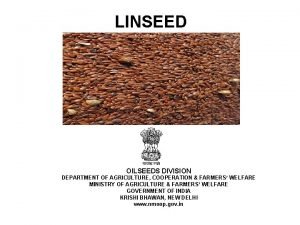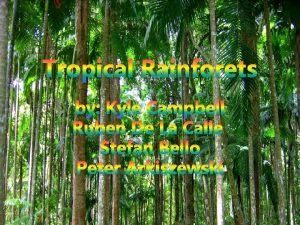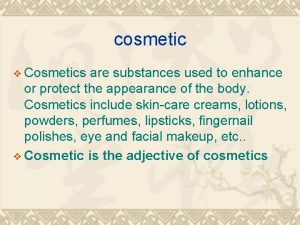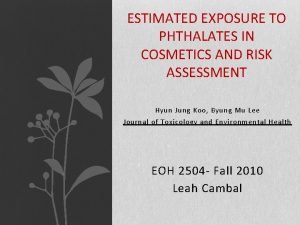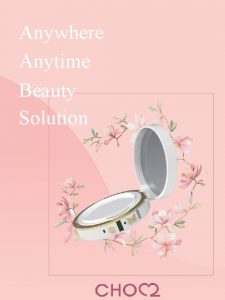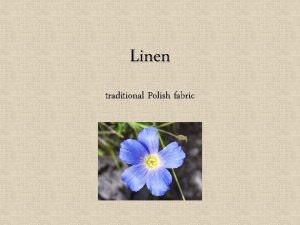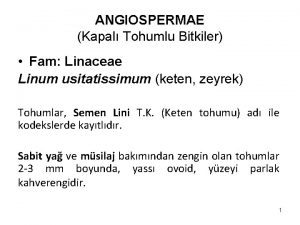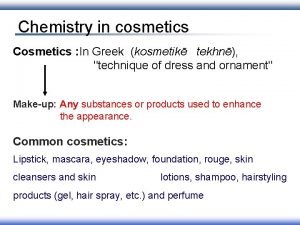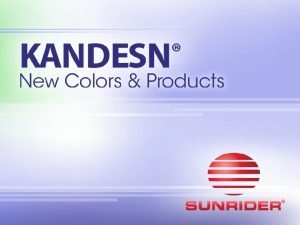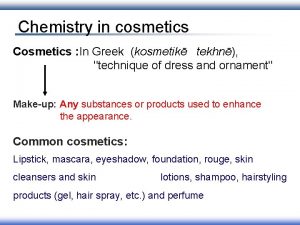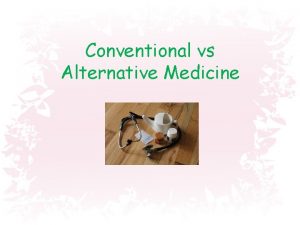LINSEEDFLAX Linum usitatissimum Linn Used for medicine cosmetics































- Slides: 31


LINSEED/FLAX (Linum usitatissimum Linn. ) • • • Used for medicine, cosmetics & Paints. Have 10 species. n=8, 9, 10, 12, 14, 15, 16, 18 Iodine number, 195 -215 Boll Five celled, two seed in each cell, 10 seed/boll Oil contents, 32 -44%


INTRODUCTION • • Botanical name: Linum usitatissimum Linn. Family: Linaceae Chromosome Number: 2 n=30 Flax is an annual and self pollinated crop with characteristic slender, strong stem and round capsule which in cultivated form don’t dehisce but retain the oval expressed shining seed. • The crop is diploid(2 n) in nature.

• In this crop, variation has been molded in the form of numerous true breeding line. Two specializition is present. Ø Oil varieties that are relatively short (3070 cm), branched, usually bear large seed. They are grown for high yield of linseed. Ø Fiber varieties are taller, sparsely branched and usually bear small seed. • Transitional form cultivated for both oil and fiber.

ORIGIN • The genus Linum has 20 species spread in warm temperate Europe and Asia and 50 species spread in America. • Most of the investigators are of the opinion that the wild flax (Linum angustifolium) which is a native of Mediterranean region may be the ancestor of the cultivated species Linum usitatissimum.

• According to Vavilov linseed or flax had two centers of origin. The small seeded type: Ø These are grown mainly for oil purpose and appear to have originated in south-western Asia comprising, India, Afghanistan and Turkey. Ø The bold seeded type: These are grown for fiber purpose and seem to have originated in the Mediterranean region including Asia Minor, Egypt, Algeria, Spain, Italy and Greece. Ø Small flax seed have been discovered in Syria dating from about 8000 BC, Iran about 7500 BC.

Importance • Seed contains 33 to 47% of oil. • About 20% of the total oil produced is used at farmer’s level, and the rest 80% oil goes to industries in various forms. • The oil is rich (> 66%) in linolenic acid and is a perfect drying oil. Hence it is utilized in the manufacture of paints, oil cloth, varnish, padink, printed ink etc.

• The oil cake is a good feed for milch cattle and poultries and hence priced 50% higher than rapeseed-mustard cake. • It is good in taste and contains 36% protein, 85% of which is digestible. • It is also used as organic manure because it contains about 5% N, 1. 4% P 2 O 5 and 1. 8% K 2 O. • Linseed is globally cultivated for its fibers and is called flax. Fibers are used for the manufacture of linen.

• The stem yields fiber of good quality having high strength and durability. The weather resistant fiber is lustrous and blends very well with wool, silk, cotton etc. Strong twines, canvas, suiting’s , shirtings and various indispensable products for defense purposes are manufactured from it. • Woody matter and short fibers may be used as raw pulp for making paper of quality comparable with that of currency notes. The rough and strong linseed fiber can effectively be used for low-cost roofing tiles based on convertible polymers and for fiberreinforced plastic (FRP).

• Flax was principal oil and fiber source in the old world and probably the earliest cultivated plant used for weaving cloth. • Flax fiber stronger then cotton and wool were the principal vegetable fiber use for textile. • However from the industrial revolution on ward, flax was gradually replaced with cotton and now completely replaced with cotton and synthetic fiber. • Seed contain as 40% oil so use as edible oil.

BOTANICAL DISCRIPTION • Growth Habit: Seed flax is an annual plant that grows to a height of 12 to 36 inches. It has a distinct main stem with numerous branches at the top which produce flowers. Branches from the base of the plant may also occur depending on variety, stand, and environment. The plant has a branched taproot system which may extend to a depth of 3 to 4 feet in coarse textured soil.


Types of flower • Funnel shape (petals overlapping but partially separate. ) • Tubular shape (petals remained curled in the form of tube). • Star shape (petals rolled the margins). • Disk shape (with large flat petals).

funnel Tubular disk star

Types of bolls • Dehiscent (open and scatter seed as soon as ripe). • Semi dehiscent (open at the apex and five segments separate slightly, American type). • Indehiscent (tightly closed Indian type).

dehiscent Semi-dehiscent Indehiscent

FLOWER • Flower symmetry- There are two or more ways to evenly divide the flower (the flower is radially symmetrical) • Flower description -The flower has a superior ovary • Flower petal color -Blue to purple • Flower reproductive parts -The flower has both pollenand seed-producing parts • Form of style -The style is knob-like at the tip, and unbranched • Fusion of petals -The petals are separate • Number of carpels : 2– 5 • Number of pistils: 2 or 5

• There are five petals, sepals in the flower • Number of styles: 5 • Ovary position : The ovary is above the point of petal and/or sepal attachment • Petal and sepal arrangement: the flower includes two cycles of petal- or sepal-like structures • Petal appearance : The petals are thin and delicate, and pigmented.

• • Petal length: 10– 23 mm Petal number: 5 Sepal number: 5 Stamen attachment: the stamens are not attached to the petals or Sepals • Stamen number: 5 • Stamens fused: the stamens are attached to one another at or near their bases


Breeding Objectives • Improving the yield potential • Improving the oil contents and oil quality • Breeding for disease resistance has resulted in cultivars that are resistant to Fusarium wilt and to rust. • Production of early maturing and fertilizer responsive varities. • genetic extension of the seed filling period.

Breeding Methods • Introduction • selection • Hybridization Ø The pedigree method Ø Backcross method Ø Recurrent selection Ø Haploid breeding

Pollination and Fertilization: • Flax is normally self-pollinated, but insects cause some natural crossing. Frequency of cross pollination seems to be associated with varietal differences and environmental conditions. Individual flowers open in the first few hours after sunrise on clear, warm days, and the petals usually fall before noon. • The flowers are protogynous. • The stigma in emasculated flowers retained its receptivity for 6 days and the pollen retained its viability from 5 -6 days.

• The amount of pollination occurring when emasculated flowers were left exposed was 710%. • By cutting off the style at varying periods after pollination the interval between pollination and fertilization was shown to be 2 -3 hours. It was also found possible for fertilization to be effected on the day before the opening of the flower.

• • • Fruits or seeds: Fruit length 6– 10 mm Fruit locules six or more Fruit shape the fruit is spherical Fruit type (general)the fruit is dry and splits open when ripe • Seed number Up to 10


Uses v Industrial uses : • Linseed oil is a common carrier used in oil paint. • Linseed oil used as a wood finish, it dries slowly and shrinks little upon hardening. linseed oil partially protects wood from denting by compression. • Linseed oil is used to bind wood dust, cork particles, and related materials in the manufacture of the floor covering linoleum

Features • Small seeded varieties have high iodine number as compared to large seeded varieties. • Oil content are reduced by high temperature, drought and diseases. • Yellow seeded varieties are superior to brown seeded in oil and iodine number. • Brown seeded varieties have higher 1000 seed weight. • Yellow seeded types are extensively dwarf. • 74% of yellow seeded types are abnormal due to split and cracked seed coats. • 25% brown seeded types are damaged or abnormal. • Large seed varieties have 2 -3% high oil than small seeded varieties.

Uses: • • • Oil cloth Textiles Wood preservation Cookware seasoning The cake obtaining after oil extraction is very nutritive food for livestock and used as an organic matter. • The fiber obtained from its stem is most valuable vegetable fiber to spin and woven into cloth. • Linseed oil is an edible oil marketed as a nutritional supplement.

• The seeds or their biologically active constituents (soluble and insoluble dietary fibre, α-linolenic acid and lignans) are use to alleviate various ailments, such as digestive complaints, high blood cholesterol and kidney diseases, hormonal problems and certain types of malignant tumours.
 Rice photos
Rice photos Mucilaginosum
Mucilaginosum Carl von linn
Carl von linn Harpy eagle eating berries
Harpy eagle eating berries Linn rasch aune
Linn rasch aune Vcosmetics
Vcosmetics Milady chapter 24 theory workbook answers
Milady chapter 24 theory workbook answers Noha moral
Noha moral Example of oily binder in compact
Example of oily binder in compact Vanesa cosmetics kala amb
Vanesa cosmetics kala amb Alquimia essential oil
Alquimia essential oil Phthalates in cosmetics
Phthalates in cosmetics Stackstorage
Stackstorage Choc choc cosmetics
Choc choc cosmetics Daughter cosmetics
Daughter cosmetics Blood bank regulation under drugs and cosmetics act
Blood bank regulation under drugs and cosmetics act Nabi cosmetics wikipedia
Nabi cosmetics wikipedia Noha cosmetic
Noha cosmetic Cosmetics business proposal
Cosmetics business proposal Mary kay cosmetics mission statement
Mary kay cosmetics mission statement Mac cosmetics target market
Mac cosmetics target market Liquid crystal cosmetics
Liquid crystal cosmetics Bsc cosmetics
Bsc cosmetics Hops assessment
Hops assessment Envelope method is used for in pharmacy
Envelope method is used for in pharmacy Borra hål för knoppar
Borra hål för knoppar Redogör för vad psykologi är
Redogör för vad psykologi är Bris för vuxna
Bris för vuxna Mat för unga idrottare
Mat för unga idrottare Etik och ledarskap etisk kod för chefer
Etik och ledarskap etisk kod för chefer Svenskt ramverk för digital samverkan
Svenskt ramverk för digital samverkan Vad är ett minoritetsspråk
Vad är ett minoritetsspråk
